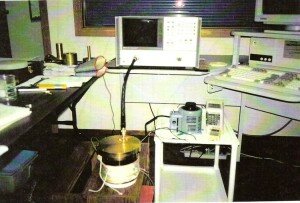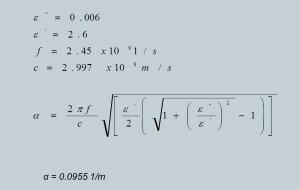A key parameter in determining the depth of penetration for a microwave beam into soil or rock is the permittivity of the material. Once the water and hydrocarbons have been removed, the permittivity of the rock will determine how far from the radiating antenna microwave energy will penetrate to heat, fracture, and remove hydrocarbons from the subsurface. Since the permittivity of the rock is extremely low, a special resonant cavity was construct and using a vector network analyzer, the permittivity of aluminum silicate material, typical of shale, was accurately measured.
With accurate data, it is possible to calculate the attenuation coefficient for microwave energy radiating in the subsurface. These calculation indicate that for most rock and soil types, it is possible to penetrate 25 meters from a well while maintaining 10 percent of the electric field strength. All hydrocarbons can be removed efficiently in a circle 50 meters in diameter or it is possible to fracture the rock and provide a low cost alternative to conventional hydrofracturing.

